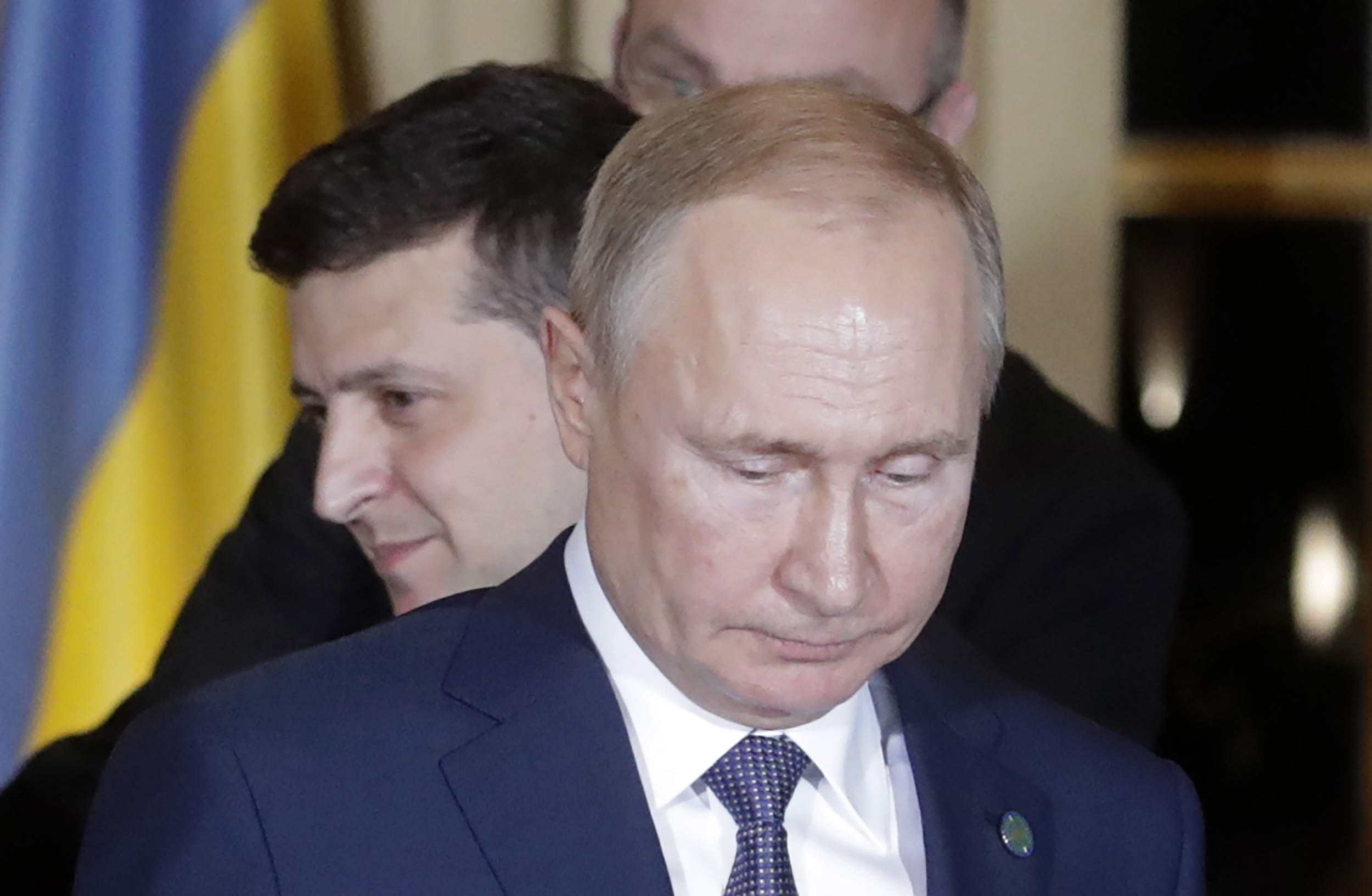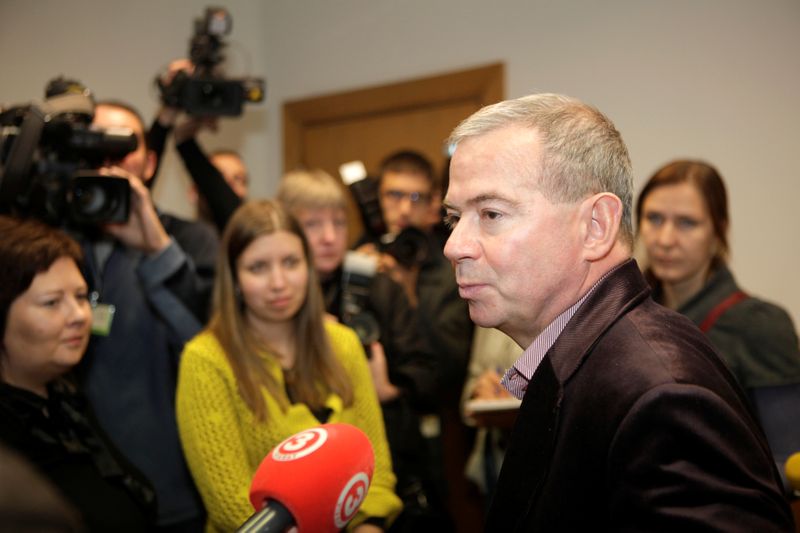
Russia’s President Vladimir Putin (front), and Ukraine’s President Volodymyr Zelenskyy (Vladimir Zelensky) attend a Normandy Four summit in the Murat Lounge in the Elysee Palace; talks in the so-called Normandy Four format involve representatives of Ukraine, Germany, France and Russia who discuss settlement of the conflict in eastern Ukraine.
Mikhail Metzel | TASS | Getty Images
Russia and Ukraine have agreed to a “full and comprehensive implementation” of a cease-fire in the Donbass region of Ukraine before the end of 2019, after peace talks in Paris on Monday, but how promises translate into action remains to be seen.
Russian President Vladimir Putin and Ukrainian President Volodymyr Zelensky met in person for the first time on Monday in a bid to resolve a long-running conflict in eastern Ukraine between pro-Russian separatists and Ukrainian forces.
Both leaders cautiously welcomed their meeting and Putin said that the process was “going in the right direction” but differences remain, including over the control of the Ukrainian-Russian border.
The conflict is one of the worst seen in modern Europe yet it is also largely seen as a “forgotten” war, having rumbled on for more than five years. In that time over 13,000 people have died, according to the United Nations, and hostilities have affected 3.9 million civilians living in the region.
Putin and Zelensky held a bilateral meeting as well as joint meetings with French President Emmanuel Macron and German Chancellor Angela Merkel, who have previously tried to broker a peace deal between the divided neighbors.
The group has become known as the “Normandy Four” and Monday was the first time it had met since October 2016.
Relations between Russia and Ukraine collapsed in early 2014 when Russia annexed Crimea from the country and then supported a pro-Russian uprising in the Donbass region in eastern Ukraine in which separatists proclaimed two pro-Russian republics of Donetsk and Luhansk. Russia is subject to international sanctions for its actions, and the lifting of some of those restrictions are tied to its implementation of a peace deal with its neighbor.
Here are three agreements that Russia and Ukraine made on Monday, according to a statement from the Elysee Palace:
1) Cease-fire before end of 2019
They agreed to implement “all necessary cease-fire support measures” to stabilize the situation in the Donbass region before the end of the year 2019.
They also agreed to disengage forces and equipment in three more unspecified areas of the Donbass region by the end of March 2020 (both Ukrainian troops and Russian-backed rebels have already pulled out of three frontline locations in recent months).
Both sides said they would release and exchange all “conflict-related detainees” by the end of 2019, adding to prisoner exchanges that have already taken place.
2) Minsk agreements
Previous peace agreements brokered by France and Germany, known as the “Minsk agreements,” were created in 2014 and 2015 and were designed to form the basis of a path to peace. But both sides accused each other of failing to comply with the terms of the Minsk agreements.
In a bid to break the deadlock , Germany’s then-Foreign Minister Frank-Walter Steinmeier came up with a plan now known as the “Steinmeier Formula.” The plan is like a road map to peace setting out a sequence of events that both sides need to enact. In October, Zelensky signed up to the “Steinmeier Formula,” causing a furor and protests at home with accusations that he had capitulated to Russia.
The agreement foresees the holding of elections in the Donbass region, under Ukrainian law and overseen by the Organisation for Security and Co-operation in Europe (OSCE). If these are deemed to be free and fair, self-governing status could be granted to separatist-held areas. Ukraine has made it clear that “foreign military formations” must be withdrawn from the Donbass region and the Ukrainian border, and that prisoner exchanges must also take place.
A soldier of Dnipro battalion prepares his machine gun while patrolling a territory near the Ukrainian-Russian border.
NurPhoto | Corbis News | Getty Images
A key sticking point between Russia and Ukraine is the order of events — and whether local elections should be held before or after Russian-backed forces have withdrawn from parts of the region.
On Monday, the statement following the meeting said that both sides agreed on “measures to implement the political provisions of the Minsk agreements” and finding legal agreement over the special status of the Donbass region. They also agreed that the Steinmeier Formula should be incorporated into Ukrainian law.
3) Keep on talking
Both sides also said they would have another meeting in the Normandy format within four months to discuss political and security conditions ahead of the organization of local elections in the Donbass region.
What everyone said?
The mood music following the meetings was cautiously optimistic, although the proof will be in the pudding, analysts like Timothy Ash, an emerging markets senior sovereign strategist at BlueBay Asset Management, noted on Tuesday.
“Some positives in terms of more de-escalation efforts in Donbass and hopes for prisoner exchanges. Hopes for a major breakthrough at this session were very low anyway,” Ash said, noting that Zelensky, as an inexperienced leader, had “played a decent diplomatic game.”
Europe has a vested interest in calming tensions between its powerful neighbor Russia and aspiring EU member Ukraine. It wants to keep Russia on side as the country is still a major energy supplier to Europe. The issue of gas transit in Europe was also discussed at Monday’s meeting.
French President Emmanuel Macron said “we saw differences today” and that “we didn’t find the miracle solution, but we have advanced on it.”

